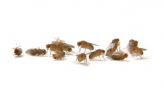(Press-News.org) Researchers from the University of Leicester have for the first time provided experimental evidence for a genetic link between two major timing mechanisms, the circadian clock and the seasonal timer.
New research from the Tauber laboratory at the University of Leicester, which will be published in the academic journal PLOS Genetics on 4 September, has corroborated previous observations that flies developed under short days become significantly more cold-resistant compared with flies raised in long-days, suggesting that this response can be used to study seasonal photoperiodic timing.
Photoperiodism is the physiological reaction of organisms to the length of day or night, occurring in both plants and animals.
Dr Mirko Pegoraro, a member of the team, explained: "The ability to tell the difference between a long and short day is essential for accurate seasonal timing, as the photoperiod changes regularly and predictably along the year."
The difference in cold response can be easily seen using the chill-coma recovery assay - in which flies exposed to freezing temperatures enter a reversible narcosis. The recovery time from this narcosis reflects how cold-adaptive the flies are.
The team has demonstrated that this response is largely regulated by the photoperiod - for example, flies exposed to short days (winter-like) during development exhibit shorter recovery times (more cold adapted) during the narcosis test.
Dr Eran Tauber from the University of Leicester's Department of Genetics explained: "Seasonal timing is a key process for survival for most organisms, especially in regions with a mild climate. In a broad range of species, from plants to mammals, the annual change in day-length is monitored by the so-called 'photoperiodic clock'.
"Many insects for example, including numerous agricultural pests, detect the shortening of the day during the autumn and switch to diapause - a developmental arrest - which allows them to survive the winter.
"Despite intensive study of the photoperiodic clock for the last 80 years, however, the underlying molecular mechanism is still largely unknown. This is in marked contrast to our understanding of the circadian clock that regulates daily rhythms."
The team has tested mutant strains in which the circadian clock is disrupted and has found that the photoperiodic clock was also disrupted, providing the first experimental evidence for the role of the circadian clock in seasonal photoperiodic timing in flies.
The new research is based on an automated system, allowing the monitoring of hundreds of flies, which paves the way for new insights into our understanding of the genes involved in the photoperiodic response and seasonal timing.
Professor Melanie Welham, Executive Director for Science, at the Biotechnology and Biological Sciences Research Council (BBSRC), said: "This study shows an interesting genetic link between the circadian clock and the seasonal timer. The ubiquity of these clocks across so many species makes this an important discovery which will lead to a better understanding of these essential processes."
INFORMATION:
The study, which was funded by the BBSRC, will be published in PLOS Genetics from 4 September 2014 at 5:00pm and will be available here: http://www.plosgenetics.org/doi/pgen.1004603
See here for more information about the Tauber Research lab: http://www.tinyurl.com/TauberLab
A video showing the fly cold response is available here: https://www.youtube.com/watch?v=oAcStLC5WO8
Breakthrough study identifies genetic link between the circadian clock and seasonal timing
University of Leicester researchers uncover new insights into day-length measurement in flies
2014-09-04
ELSE PRESS RELEASES FROM THIS DATE:
The yin and yang of overcoming cocaine addiction
2014-09-04
PITTSBURGH—Yaoying Ma says that biology, by nature, has a yin and a yang—a push and a pull.
Addiction, particularly relapse, she finds, is no exception.
Ma is a research associate in the lab of Yan Dong, assistant professor of neuroscience in the University of Pittsburgh's Kenneth P. Dietrich School of Arts and Sciences. She is the lead author of a paper published online today in the journal Neuron that posits that it may be possible to ramp up an intrinsic anti-addiction response as a means to fight cocaine relapse and keep the wolves of relapse at bay.
This paper ...
A metallic alloy that is tough and ductile at cryogenic temperatures
2014-09-04
A new concept in metallic alloy design – called "high-entropy alloys" - has yielded a multiple-element material that not only tests out as one of the toughest on record, but, unlike most materials, the toughness as well as the strength and ductility of this alloy actually improves at cryogenic temperatures. This multi-element alloy was synthesized and tested through a collaboration of researchers at the U.S. Department of Energy (DOE)'s Lawrence Berkeley and Oak Ridge National Laboratories (Berkeley Lab and ORNL).
"We examined CrMnFeCoNi, a high-entropy alloy that contains ...
Rosetta-Alice spectrograph obtains first far ultraviolet spectra of a cometary surface
2014-09-04
Boulder, Colo. — Sept. 4, 2014 — NASA's Alice ultraviolet (UV) spectrograph aboard the European Space Agency's Rosetta comet orbiter has delivered its first scientific discoveries. Rosetta, in orbit around comet 67P/Churyumov-Gerasimenko, is the first spacecraft to study a comet up close.
As Alice began mapping the comet's surface last month, it made the first far ultraviolet spectra of a cometary surface. From these data, the Alice team discovered that the comet is unusually dark at ultraviolet wavelengths and that the comet's surface — so far — shows no large water-ice ...
Avian influenza virus isolated in harbor seals poses a threat to humans
2014-09-04
(MEMPHIS, Tenn. – September 4, 2014) A study led by St. Jude Children's Research Hospital scientists found the avian influenza A H3N8 virus that killed harbor seals along the New England coast can spread through respiratory droplets and poses a threat to humans. The research appears in the current issue of the scientific journal Nature Communications.
The avian H3N8 virus was isolated by scientists investigating the 2011 deaths of more than 160 harbor seals. Researchers discovered the virus had naturally acquired mutations in a key protein that previous laboratory research ...
2-D or 3-D? That is the question
2014-09-04
The increased visual realism of 3-D films is believed to offer viewers a more vivid and lifelike experience—more thrilling and intense than 2-D because it more closely approximates real life. However, psychology researchers at the University of Utah, among those who use film clips routinely in the lab to study patients' emotional conditions, have found that there is no significant difference between the two formats. The results were published recently in PLOS ONE.
The study aimed to validate the effectiveness of 3-D film, a newer technology, as compared to 2-D film that ...
Team identifies important regulators of immune cell response
2014-09-04
JUPITER, FL, September 4, 2014 - In a collaborative study, scientists from the Florida campus of The Scripps Research Institute (TSRI) and the La Jolla Institute for Allergy and Immunology have developed a more effective method to determine how immune cells called T cells differentiate into specialized types of cells that help eradicate infected cells and assist other immune cells during infection.
The new approach, published recently by the journal Immunity, could help accelerate laboratory research and the development of potential therapeutics, including vaccines. The ...
Knowing how bacteria take out trash could lead to new antibiotics
2014-09-04
AMHERST, Mass. – A collaborative team of scientists including biochemist Peter Chien at the University of Massachusetts Amherst has reconstructed how bacteria tightly control their growth and division, a process known as the cell cycle, by specifically destroying key proteins through regulated protein degradation.
Regulated protein degradation uses specific enzymes called energy dependent proteases to selective destroy certain targets. Because regulated protein degradation is critical for bacterial virulence and invasion, understanding how these proteases function should ...
Reacting to personal setbacks: Do you bounce back or give up?
2014-09-04
Sometimes when people get upsetting news – such as a failing exam grade or a negative job review – they decide instantly to do better the next time. In other situations that are equally disappointing, the same people may feel inclined to just give up.
How can similar setbacks produce such different reactions? It may come down to how much control we feel we have over what happened, according to new research from Rutgers University-Newark.
The study, published in the journal Neuron, also finds that when these setbacks occur, the level of control we perceive may even determine ...
Plant-based research at Penn prevents complication of hemophilia treatment in mice
2014-09-04
While healthy people have proteins in their blood called clotting factors that act quickly to plug wounds, hemophiliacs lack these proteins, making even minor bleeds difficult to stop.
The main treatment option for people with severe hemophilia is to receive regular infusions of clotting factor. But 20 to 30 percent of people who get these infusions develop antibodies, called inhibitors, against the clotting factor. Once these inhibitors develop, it can be very difficult to treat or prevent future bleeding episodes.
In a new study, researchers from the University of ...
LSU Health research discovers new therapeutic target for diabetic wound healing
2014-09-04
New Orleans, LA – Research led by scientists in Dr. Song Hong's group at LSU Health New Orleans has identified a novel family of chemical mediators that rescue the reparative functions of macrophages (a main type of mature white blood cells) impaired by diabetes, restoring their ability to resolve inflammation and heal wounds. The research is in-press and is scheduled to be published in the October 23, 2014 issue of Chemistry & Biology, a Cell Press journal.
The white blood cells, or leukocytes, of the immune system, help defend the body against infection or foreign ...
LAST 30 PRESS RELEASES:
Air pollution exposure and birth weight
Obstructive sleep apnea risk and mental health conditions among older adults
How talking slows eye movements behind the wheel
The Ceramic Society of Japan’s Oxoate Ceramics Research Association launches new international book project
Heart-brain connection: international study reveals the role of the vagus nerve in keeping the heart young
Researchers identify Rb1 as a predictive biomarker for a new therapeutic strategy in some breast cancers
Survey reveals ethical gaps slowing AI adoption in pediatric surgery
Stimulant ADHD medications work differently than thought
AI overestimates how smart people are, according to HSE economists
HSE researchers create genome-wide map of quadruplexes
Scientists boost cell "powerhouses" to burn more calories
Automatic label checking: The missing step in making reliable medical AI
Low daily alcohol intake linked to 50% heightened mouth cancer risk in India
American Meteorological Society announces Rick Spinrad as 2026 President-Elect
Biomass-based carbon capture spotlighted in newly released global climate webinar recording
Illuminating invisible nano pollutants: advanced bioimaging tracks the full journey of emerging nanoscale contaminants in living systems
How does age affect recovery from spinal cord injury?
Novel AI tool offers prognosis for patients with head and neck cancer
Fathers’ microplastic exposure tied to their children’s metabolic problems
Research validates laboratory model for studying high-grade serous ovarian cancer
SIR 2026 delivers transformative breakthroughs in minimally invasive medicine to improve patient care
Stem Cell Reports most downloaded papers of 2025 highlight the breadth and impact of stem cell research
Oxford-led study estimates NHS spends around 3% of its primary and secondary care budget on the health impacts of heat and cold in England
A researcher’s long quest leads to a smart composite breakthrough
Urban wild bees act as “microbial sensors” of city health.
New study finds where you live affects recovery after a hip fracture
Forecasting the impact of fully automated vehicle adoption on US road traffic injuries
Alcohol-related hospitalizations from 2016 to 2022
Semaglutide and hospitalizations in patients with obesity and established cardiovascular disease
Researchers ‘listen in’ to embryo-mother interactions during implantation using a culture system replicating the womb lining
[Press-News.org] Breakthrough study identifies genetic link between the circadian clock and seasonal timingUniversity of Leicester researchers uncover new insights into day-length measurement in flies





